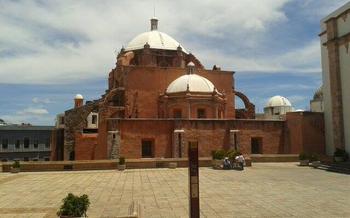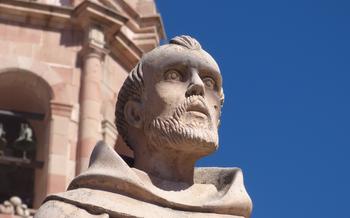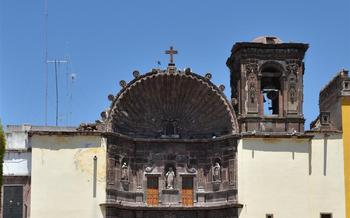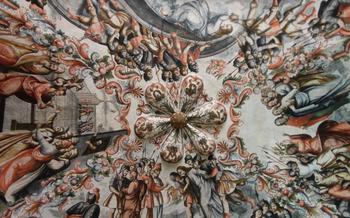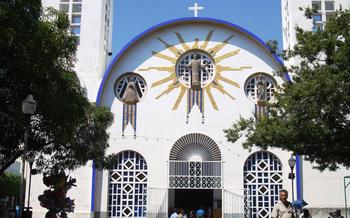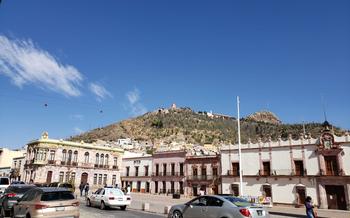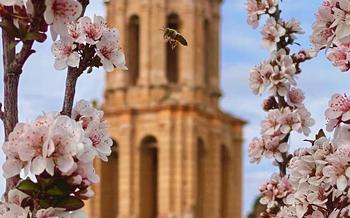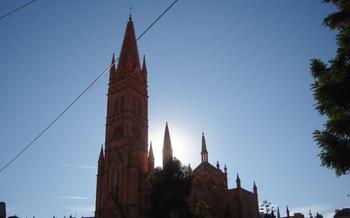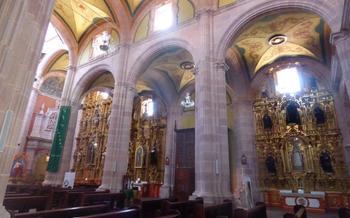
Church of Santo Domingo
- Historical Significance:
- Architectural Marvel
- Interior Splendor
- The Rose Window
- The Chapel of Our Lady of Sorrows
- The Museum
- Visiting Information
- Location and Accessibility
- Historical Context
- Restoration Efforts
- Local Legends and Beliefs:
- Cultural Significance
- Photography Tips
- Suggested Itineraries
- Insider Tip: Discovering the Hidden Choir Loft
Historical Significance:
Embark on a journey through time as we explore the Church of Santo Domingo, a testament to the rich heritage of Zacatecas. Constructed in the 18th century, this architectural masterpiece has stood as a beacon of faith for generations. Originally serving as a convent for the Dominican Order, it underwent a transformation into a church in the 19th century, solidifying its role as a spiritual center for the community. As we delve into its history, we uncover the profound impact it has had on the cultural and religious landscape of Zacatecas, showcasing the enduring legacy of its past.
Architectural Marvel
The Church of Santo Domingo stands as a testament to the grandeur of Baroque architecture. Its facade is a masterpiece of intricate carvings, sculptures, and ornate ornamentation, creating a visual spectacle that captivates the beholder. The unique Churrigueresque style, characterized by its excessive decoration and exuberant forms, is evident in every detail of the church's exterior.
The grand entrance, flanked by towering columns and topped by a graceful arch, invites visitors into a world of artistic and religious wonders. The intricate carvings depict scenes from the Bible, the lives of saints, and other religious motifs, adding depth and meaning to the church's facade. The profusion of decorative elements, including cherubs, garlands, and scrolling patterns, creates a sense of movement and energy, making the church appear almost alive.
The symbolism embedded in the architectural details of the Church of Santo Domingo is profound and thought-provoking. Each element, from the sculptures to the carvings, carries a religious message or represents a biblical figure. The facade is a visual representation of the church's dedication to Catholicism and its mission to spread the faith.
This architectural marvel is a testament to the skill and artistry of the Baroque era. Its facade is a symphony of stone and ornament, inviting visitors to contemplate the beauty of its intricate details and the religious symbolism that lies within.
Interior Splendor
The interior of the Church of Santo Domingo is a testament to the grandeur and artistry of Baroque architecture. As you step inside, the vast nave stretches before you, flanked by a series of intricate side chapels. The grand altar, a masterpiece of gold leaf and intricate artwork, dominates the sanctuary, drawing the eye with its radiant beauty. The walls and ceilings are adorned with stunning murals and paintings, depicting religious scenes and biblical narratives with vivid colors and lifelike detail. The overall effect is one of awe-inspiring splendor, a testament to the skill and devotion of the artisans who created this sacred space.
The Rose Window
Above the main entrance of the Church of Santo Domingo, a magnificent rose window captures the attention of visitors with its intricate design and vibrant colors. This breathtaking stained-glass masterpiece is a testament to the skill and artistry of the craftsmen who created it. The window depicts various religious scenes and symbols, each carefully arranged to convey a deeper spiritual message.
The central figure in the rose window is Jesus Christ, surrounded by a halo of golden light. His arms are outstretched, welcoming all who enter the church. The surrounding panels depict scenes from the Bible, including the Annunciation, the Nativity, and the Resurrection. These scenes are rendered in vivid detail, with rich colors that seem to come alive in the sunlight.
The symbolism of the rose window is profound. The circle represents eternity, while the spokes represent the rays of divine light emanating from Christ. The various scenes depicted in the window tell the story of salvation, from the fall of man to the redemption offered by Jesus Christ. The window serves as a reminder of the church's role as a place of worship, contemplation, and spiritual renewal.
As the sunlight streams through the rose window, it casts a kaleidoscope of colors onto the interior of the church. This creates a magical and awe-inspiring atmosphere, inviting visitors to pause and reflect on the beauty of the sacred space they have entered. The rose window is not just a decorative element; it is a powerful symbol of faith and a reminder of the divine presence that dwells within the Church of Santo Domingo.
The Chapel of Our Lady of Sorrows
Nestled within the Church of Santo Domingo, the Chapel of Our Lady of Sorrows holds a special place in the hearts of Zacatecans. Dedicated to the Virgin Mary, the chapel exudes a serene and devotional atmosphere. The exquisite altar, adorned with intricate carvings and artwork, is a testament to the devotion and artistry of the people of Zacatecas.
The Virgin Mary, known as Our Lady of Sorrows, holds a profound significance in Mexican culture. She is revered as a symbol of compassion, empathy, and maternal love. In Zacatecas, Our Lady of Sorrows is deeply venerated, and her chapel within the Church of Santo Domingo serves as a place of pilgrimage and prayer for many faithful devotees.
Throughout the year, the chapel hosts various religious celebrations and events dedicated to Our Lady of Sorrows. During these occasions, the chapel is adorned with colorful decorations, flowers, and candles, creating a vibrant and festive atmosphere. Pilgrims from near and far flock to the chapel to pay their respects and seek blessings from the Virgin Mary.
The Chapel of Our Lady of Sorrows is not just a place of worship but also a testament to the rich cultural and religious heritage of Zacatecas. It embodies the deep devotion and faith of the people of Zacatecas and serves as a reminder of the important role that religion has played in shaping the history and identity of this vibrant city.
The Museum
Within the confines of the revered Church of Santo Domingo lies a treasure trove of religious art and artifacts, carefully curated in a museum that invites visitors to delve deeper into Zacatecas's rich cultural and spiritual heritage. The museum's collection is a testament to the enduring legacy of the colonial era, showcasing exquisite paintings, intricate sculptures, and precious liturgical objects that adorned the church during its early years.
Visitors can marvel at the masterful brushstrokes of renowned artists who captured the essence of religious devotion on canvas. The sculptures, crafted with meticulous detail, depict biblical figures and saints with lifelike expressions and graceful postures. Among the most captivating pieces is a collection of intricately carved wooden santos, each representing a different patron saint and embodying the deep faith of the local community.
The museum also houses a collection of liturgical objects that provide a glimpse into the rituals and practices of the Catholic Church during the colonial period. From ornate chalices and censers to finely embroidered vestments, these objects offer a tangible connection to the past and a deeper understanding of the role religion played in shaping the cultural identity of Zacatecas.
This museum is not just a repository of artifacts; it is a testament to the enduring power of faith and the artistic legacy of a bygone era. By preserving and showcasing these precious objects, the museum plays a vital role in safeguarding Zacatecas's cultural heritage for generations to come.
Visiting Information
Visiting the Church of Santo Domingo is a must for anyone interested in history, architecture, and art. To make the most of your visit, here are some practical tips to consider:
Visiting Hours: The church is generally open to the public daily from 9:00 AM to 6:00 PM. It is recommended to arrive early in the morning or late in the afternoon to avoid crowds, especially during peak tourist season.
Admission Fees: Entrance to the church is free of charge. However, there is a small fee for guided tours, which are highly recommended for a more in-depth understanding of the church's history and significance.
Guided Tours: Guided tours are available in English and Spanish at various times throughout the day. The knowledgeable guides provide insights into the church's architecture, artwork, and religious significance.
Audio Guides and Brochures: For those who prefer to explore at their own pace, audio guides and brochures are available in multiple languages. These self-guided tours offer a comprehensive overview of the church's highlights.
Best Time to Visit: The best time to visit the Church of Santo Domingo is during the shoulder season (May-June and September-October) when the weather is pleasant and the crowds are smaller. During the summer months, the church can get quite busy due to the influx of tourists.
Dress Code: As a place of worship, visitors are expected to dress respectfully. Shorts, tank tops, and revealing clothing are discouraged. It is recommended to wear comfortable shoes as there is a lot of walking involved.
By following these tips, you can ensure a memorable and enriching visit to the Church of Santo Domingo, one of Zacatecas's most iconic landmarks.
Location and Accessibility
The Church of Santo Domingo is conveniently located in the historic center of Zacatecas, making it easily accessible on foot or by public transportation. Its proximity to other attractions, such as the Plaza de Armas, the Zacatecas Cathedral, and the Rafael Coronel Museum, allows visitors to explore the city's rich heritage in a single day. The church is situated on Avenida Hidalgo, a bustling pedestrian street lined with shops, restaurants, and cafes, inviting visitors to immerse themselves in the vibrant local culture. Whether arriving by car or on foot, the church's grandeur and architectural details are sure to captivate and inspire awe in all who visit.
Historical Context
The Church of Santo Domingo stands as a testament to the rich history of Zacatecas, deeply intertwined with the Dominican Order and the economic prosperity of the colonial era. During the 18th century, Zacatecas emerged as a thriving mining center, attracting settlers and fortune seekers from across the region. The Dominican Order, renowned for its missionary work and educational institutions, established a presence in Zacatecas, recognizing its strategic importance.
The construction of the Church of Santo Domingo during this period reflected the growing wealth and influence of the city. The Dominicans, with their expertise in architecture and theology, played a pivotal role in shaping the church's design and ornamentation. The church's grand scale and exquisite decoration mirrored the economic prosperity of Zacatecas, showcasing the city's status as a major mining hub.
Restoration Efforts
The Church of Santo Domingo has undergone meticulous restoration efforts over the years to preserve its architectural integrity and historical significance. The challenges faced by conservators were substantial, as the church had suffered from natural wear and tear, as well as damage caused by previous renovations and alterations.
One of the primary challenges was addressing the structural issues that had developed over time. The weight of the elaborate facade and the bell towers had caused the walls to buckle and crack, compromising the stability of the building. To rectify this, engineers employed a combination of traditional techniques and modern engineering solutions to reinforce the foundations and strengthen the overall structure.
Another challenge was restoring the intricate carvings and sculptures that adorned the church's exterior. Many of these decorative elements had eroded or been damaged by weather and pollution. Skilled artisans meticulously cleaned and repaired the stonework, using traditional techniques to ensure that the original details and artistic intent were preserved.
The interior of the church also required extensive restoration work. The stunning altarpieces, murals, and paintings had suffered from centuries of exposure to dust, humidity, and candle smoke. Conservators employed specialized cleaning methods and techniques to remove grime and restore the vibrant colors and intricate details of these artworks.
Through the dedication and expertise of conservators, the Church of Santo Domingo has been restored to its former glory, allowing visitors to appreciate its architectural splendor and artistic treasures for generations to come.
Local Legends and Beliefs:
The Church of Santo Domingo is steeped in local legends and beliefs that have been passed down through generations, adding to its mystique and cultural significance. One popular legend tells the tale of a hidden treasure buried beneath the church's altar. According to the legend, the treasure was hidden by a wealthy family during the Mexican Revolution to protect it from being looted. Despite numerous attempts to find the treasure, it remains undiscovered, fueling the imaginations of locals and visitors alike.
Another belief associated with the church is the miraculous healing powers of the statue of Our Lady of Sorrows. Devotees believe that the statue possesses the power to heal the sick and grant miracles to those who pray to her with a pure heart. Many pilgrims visit the church to seek blessings and pray for healing, often leaving behind offerings and tokens of gratitude.
These local legends and beliefs contribute to the unique charm and allure of the Church of Santo Domingo, making it not only a religious and architectural marvel but also a place of mystery and devotion for the people of Zacatecas.
Cultural Significance
The Church of Santo Domingo holds immense cultural significance as a symbol of Zacatecas's rich history and heritage. It stands as a testament to the city's colonial past, showcasing the fusion of Spanish and indigenous cultures. The church serves as a venue for religious celebrations, festivals, and other cultural events, bringing the community together to honor their traditions and faith. Its recognition as a UNESCO World Heritage Site further solidifies its importance as a cultural landmark, attracting tourists from around the world to admire its architectural grandeur and historical significance. The Church of Santo Domingo serves as a reminder of Zacatecas's cultural heritage and is a source of pride for the local community.
Photography Tips
Capturing the beauty of the Church of Santo Domingo through photography is a rewarding experience. To take stunning shots, consider the following tips:
-
Golden Hour Magic: The best time to photograph the church's exterior is during the golden hour, just after sunrise or before sunset. The warm, diffused light during these times enhances the architectural details and creates a magical atmosphere.
-
Experiment with Angles: Don't limit yourself to straight-on shots. Try capturing the church from different angles to create dynamic compositions. Experiment with low angles to emphasize the grandeur of the facade or high angles to showcase the intricate roofline.
-
Interior Details: While the exterior is impressive, don't miss the opportunity to photograph the stunning interior. Capture the intricate carvings of the altarpieces, the vibrant murals, and the colorful stained-glass windows.
-
Tripod Stability: A tripod is essential for sharp and steady shots, especially in low-light conditions. Use a sturdy tripod to minimize camera shake and capture the fine details of the church's architecture.
-
Respectful Photography: Remember to be respectful of other visitors and worshippers while taking photographs. Avoid using flash or disruptive lighting that may disturb religious services or ceremonies.
Suggested Itineraries
Begin your exploration of Zacatecas by immersing yourself in the architectural splendor of the Church of Santo Domingo. Allow at least an hour to wander through its awe-inspiring interior, marveling at the intricate details and stunning artwork. Take your time to appreciate the exquisite rose window, the Chapel of Our Lady of Sorrows, and the museum's collection of religious artifacts.
After delving into the history and beauty of the church, step outside and explore the vibrant Plaza de Armas, the heart of Zacatecas' historic center. This lively square is surrounded by charming cafes, restaurants, and shops, offering a delightful respite to soak in the city's atmosphere.
From the Plaza de Armas, stroll down Calle Hidalgo, lined with historic buildings and boutiques. Make your way to the Zacatecas Cathedral, another architectural masterpiece that showcases a blend of Gothic and Baroque styles. Take a guided tour to learn about its fascinating history and admire its stunning stained-glass windows.
For a panoramic view of the city, ascend to the El Cerro de la Bufa, a hilltop park that offers breathtaking vistas of Zacatecas and its surroundings. Explore the park's walking trails, visit the Museo Toma de Zacatecas, and enjoy a leisurely picnic amidst the serene landscape.
To further immerse yourself in the city's rich mining heritage, visit the Mina El Edén, a former silver mine that has been transformed into a museum. Descend into the depths of the mine to learn about the history of mining in Zacatecas and experience the challenges faced by miners.
As the day draws to a close, savor the magical ambiance of Zacatecas by taking a leisurely stroll through its charming streets. Admire the colonial architecture, soak in the vibrant atmosphere, and indulge in the local cuisine at one of the many traditional restaurants.
Zacatecas offers a captivating blend of history, architecture, and culture, inviting you to discover its hidden gems and create lasting memories.
Insider Tip: Discovering the Hidden Choir Loft
While exploring the Church of Santo Domingo, make sure to venture beyond the main tourist areas to discover its hidden gem – the choir loft. Located above the main entrance, this secluded spot offers a unique perspective of the church's interior and a glimpse into its musical heritage.
Climb the narrow staircase to reach the choir loft and be greeted by a breathtaking view of the grand nave and altar. From this vantage point, you can admire the intricate details of the church's architecture, the stunning murals adorning the walls, and the magnificent rose window above the main entrance.
Imagine the melodious sounds of the choir resonating through the church as they perform during religious services or special events. The choir loft's acoustics are exceptional, creating a truly immersive experience for both the performers and the congregation below.
This hidden gem is often overlooked by visitors, but it offers a rare opportunity to appreciate the church's beauty from a different angle and gain a deeper understanding of its rich musical traditions. Don't miss the chance to explore the choir loft and discover this hidden treasure within the Church of Santo Domingo.
